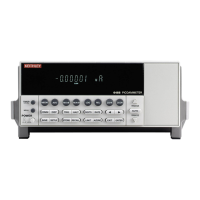4-10 Range, Units, Digits, Rate, and Filters Model 6485 Picoammeter Instruction Manual
Figure 4-3
Digital filter types; moving and repeating
Response time
The various filter parameters have the following effects on the time needed to display,
store, or output a filtered reading:
• Filter classification: The time to the first reading is the same for both classifica-
tions, but thereafter, the moving mode yields a faster reading than repeating mode.
Also, advanced has a faster response to changes in the input signal than averaging.
• Number of reading conversions: Speed and noise are tradeoffs.
• Noise window: For the advanced filter, a tradeoff of speed, noise, and response to input
signal changes.
Operation consideration
• The digital filter operation will reset (start over) whenever the zero check operation
is performed or the range is changed.
Conversion
#10
#9
#8
#7
#6
#5
#4
#3
#2
#1
Conversion
Reading
#10
Conversion
#12
#11
#10
#9
#8
#7
#6
#5
#4
#3
Conversion
Reading
#12
Conversion
#11
#10
#9
#8
#7
#6
#5
#4
#3
#2
Conversion
Reading
#11
A. Class - Average, Readings = 10, Type - Moving
Conversion
#10
#9
#8
#7
#6
#5
#4
#3
#2
#1
Conversion
Reading
#1
Conversion
#20
#19
#18
#17
#16
#15
#14
#13
#12
#11
Conversion
Reading
#2
Conversion
#30
#29
#28
#27
#26
#25
#24
#23
#22
#21
Conversion
Reading
#3
B. Class - Average, Readings = 10, Type - Repeating

